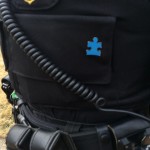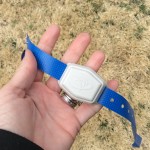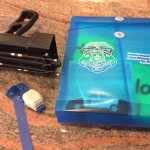
Aspen Hill Autistic Boy Found Safe Thanks to Project Lifesaver (VIDEO & PHOTOS)
Kat Trammell-O’Brien was unpacking her car late last week about 4 p.m. when her two boys headed to the backyard to play. What happened in the next 30 minutes she said was an example of an autism emergency plan that worked.
Ten-year-old Connor, who has autism, wears a Project Lifesaver tracking bracelet that led trained Montgomery County Police officers to find him less than a mile away and about 20 minutes after his mom called 9-1-1.
Connor is registered through the county’s Autism Outreach program and so when 9-1-1 operators got the call he had wandered off, the Project Lifesaver investigation launched which deploys officers with the radio frequency tracking equipment to his Aspen Hill home and also gives officers insights into things that would attract Connor like nearby streambeds.
Sgt. Jeffrey Bunge coordinated the short search effort deploying officers in the neighborhood to look for the boy.
“It’s important that we respond quickly to these types of calls,” he said.
Trammell-O-Brien said her son has limited communication skills and has wandered away one time before he had the tracking bracelet. She said he wears it without much trouble now.
“I made him say thank you to the officers who responded,” she said.
Project Lifesaver began about 10 years ago and participants started to wear the trackable bracelets since 2006. In Montgomery County there are two to three 9-1-1 calls each week for missing persons with Autism, Alzheimer’s or other cognitive disorders, according to Officer Laurie Reyes, who coordinates the program. Currently there are 65 county residents with the tracking device and more on a waiting list to get them. The tracking system uses radio frequency signals that are unique to each bracelet. Reyes said GPS systems proved to have a short battery life so the department is sticking with the technology that is more than 50 years old. The signals can be tracked up to a mile away on the ground and from three miles away from the air.
The program is funded by the county with the help of donations and some federal and state grants. The bracelets have a 45-day battery life and officers visit program participants once a month to change the battery and meet with the family enrolled in the program. The tracking bracelets are just one part of Project Lifesaver. Other elements include a plan to help avoid wandering and items to help in their safe return like decals for homes and vehicles so officers are alerted that someone in the program is inside. It also includes a special T-shirt that identifies the person as having autism. There are more than 200 participants in that program.
For more information or for assistance in dealing with wandering, contact Officer Laurie Reyes via e-mail at Laurie.Reyes@montgomerycountymd.gov.
More information about wandering prevention, the Autism Outreach Program, and Project Lifesaver can be found on the Department’s website at: http://www.mymcpnews.com/resources/project-lifesaver/






Engage us on Facebook
Follow us on Twitter
Tweets by @mymcmedia